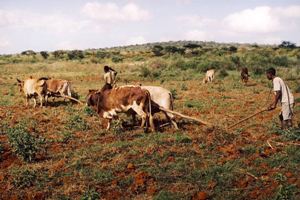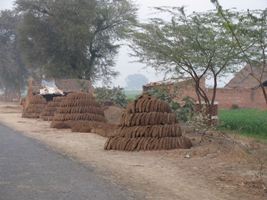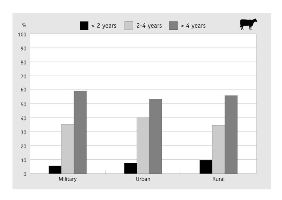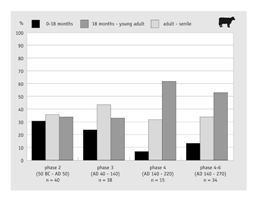

Figure 33: Cattle used for ploughing with an ard in Ethiopia. Photo L.I. Kooistra.
Figure 34: Cow dung patties used for fuel in India. Photo M. Groot.
Cattle comprise the most prominent animal in number of fragments (for 4 out of 6 phases in Passewaaijse Hogeweg, and in all phases in Oude Tielseweg). The high percentage of fragments and their large body size in comparison to sheep and pig mean that cattle provided the bulk of the meat consumed in rural settlements. Apart from meat, cattle provided several other products, such as manure, labour, milk, hides, horn and bone. The importance of manure and labour to arable agriculture should not be underestimated (Fig. 33). Pathological changes in cattle bones (arthritic changes in the hip joint) attest the use of cattle as draught animals (Groot 2005). Interestingly, it is not oxen, but cows that were used to draw ploughs and carts. Recent research at a similar site has shown that nearly 90% of adult cattle were females (Groot 2009, 362). Manure could also have been used as fuel, although there is no evidence that this occurred. However, peat is not accessible in this area and trees were rather scarce, so manure could have been an alternative type of fuel (Fig. 34). Another way in which cattle contribute to arable agriculture in many societies is in threshing cereals.


Figure 33: Cattle used for ploughing with an ard in Ethiopia. Photo L.I. Kooistra.
Figure 34: Cow dung patties used for fuel in India. Photo M. Groot.
Beef was not only the main type of meat in the diet in rural settlements, but also in the Roman army camps. Cattle were almost certainly supplied by local communities. However, this has left no recognisable mark on the mortality profiles found in Tiel-Passewaaij and other settlements and army camps (Fig. 35). Instead of finding young adult animals in consumption sites, the age distribution is similar to that in production sites such as Passewaaijse Hogeweg. Apparently, there was no specialised beef production system. Rural settlements sold their surplus animals, most of which were older adults, to consumers. Quantification based on stable sizes and the proportion of beef in the diet of rural inhabitants suggests that a surplus of cattle could have been raised in Tiel-Passewaaij before AD 50 and between AD 150 and 200 (Groot et al. in press).

Figure 35: Mortality profiles for cattle in rural production (Tiel-Passewaaijse Hogeweg) and urban and military consumption sites (Nijmegen-Maasplein, Nijmegen-castra, Nijmegen-canabae) (Lauwerier 1988; Filean 2006). Illustration Bert Brouwenstijn, ACVU.
The byrehouse, the farmhouse typical for the Batavian region, offered stabling for livestock. The dimensions of stalls found in some byrehouses suggest that cattle were the main type of livestock housed in the byrehouse. It is likely that the cattle that were used to plough the fields or transport goods were stabled permanently. Additionally, any cows that produced milk, together with their young calves, were probably stabled overnight and during winter. This makes milking and the collection of manure a simple task. Any animals that were stabled, either during nights or winter, must have required extra food. The collection of fodder was therefore an important task.
Young calves are found in nearly all phases (the absence in phase 4 is probably due to the small sample size), in contrast to sheep, where the youngest age category is missing. This reflects a difference in the way cattle and sheep were managed. Cattle seem to have been kept closer to the settlement, and probably spent more time stabled than the other livestock. This could be related to the use of milk or the desirability of cattle manure over that of other animals. It is also possible that cattle required more care (extra feeding?) than sheep and horses.
The average age at slaughter of cattle in Tiel-Passewaaijse Hogeweg increases during the Roman period (Fig. 36). A change in exploitation seems to have taken place around the middle of the 2nd century, with more cattle reaching adulthood or an even older age. In Geldermalsen-Hondsgemet, the proportion of adult and old cattle increases from the Early Roman period onwards, but this increase is more subtle when compared to Passewaaijse Hogeweg. Keeping more cattle alive to an older age can reflect an emphasis on products of the living animal. These products did not consist primarily of milk and calves – in that case, we would find a higher proportion of young animals killed, either in Tiel-Passewaaij itself or in consumption sites such as military forts – but almost certainly of manure and labour. An exploitation of cattle geared towards higher yields of manure can indicate more intensive arable farming – higher yields from the same area – soil exhaustion, or farming of a larger area.

Figure 36: Mortality profile for cattle per phase in Tiel-Passewaaijse Hogeweg, based on tooth wear (Grant 1982). n is the number of mandibles for which tooth wear has been assessed. Illustration Bert Brouwenstijn, ACVU.
Cattle would not require a lot of labour if they were kept at pasture. If many animals were stabled (needing fodder), or if dairy was important, a larger workforce would be needed.
© Internet Archaeology/Author(s)
URL: http://intarch.ac.uk/journal/issue27/5/3.3.1.html
Last updated: Tue Nov 10 2009